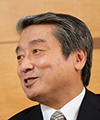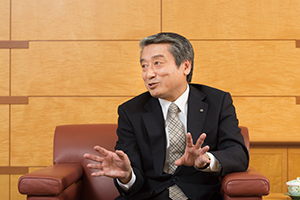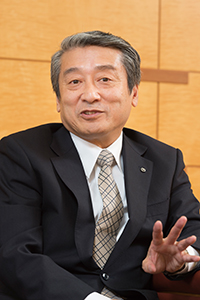 |
|||||
|
|
|||||
|
View from the Top Vol. 13, No. 12, pp. 1–5, Dec. 2015. https://doi.org/10.53829/ntr201512tp1  NTT EAST at a Major Turning Point in Business Structure—All Employees Working as One to Reform the Business Model toward Sustainable ManagementOverviewThe growth of FLET’S HIKARI—NTT’s optical access broadband service and flagship product—shows signs of slowing down as the demand for high-speed Internet eases and competition with optical access services of other companies intensifies. Under these conditions, NTT EAST is reexamining its business structure and reforming its business model to steer the company toward sustainable management while growing its business-user market. We asked Hiroshi Nakagawa, Senior Executive Vice President of NTT EAST, to tell us about the aims and rollout of the Hikari Collaboration Model and specific initiatives such as the new marketing method called ICT Concierge. Keywords: optical access, FLET’S HIKARI, Hikari Collaboration Opening up the future through employee efforts—turning to profit-oriented management and reforming the business structure—Mr. Nakagawa, please tell us about the business environment surrounding NTT EAST. NTT EAST is now at a major turning point. Since fiscal year 2014, we have been making changes to our business structure and tackling various tasks in reforming our business model. The history of the company up to now has been a history of expanding FLET’S HIKARI. As you know, NTT EAST is a company that carries on the work of the former Nippon Telegraph and Telephone Public Corporation, which means that the foundation of its business is the traditional growth-in-numbers model. In line with this business model, we began the full-scale provision of our B FLET’S optical access broadband service in 2001. Since then, we have expanded the service coverage area and deployed splitter equipment in condominium buildings, and we have steadily increased our number of subscribers while improving the usage environment for optical broadband services. As a result of implementing these measures, we have grown our optical access business to a level that surpassed 10 million subscribers in 2015. I attribute this success to the personal efforts of the employees of the NTT EAST Group, our subcontractors responsible for sales and access-line installation, and our research team that works tirelessly to develop compact equipment and efficient installation methods. However, the growth in the number of subscribers has slowed as the demand for high-speed Internet eases, thereby reducing the number of new lines. Service terminations have also increased as some customers switch to other companies’ services. This ease in the demand for high-speed Internet can be attributed to a change in Internet terminals, that is, from connecting to a fixed network with a personal computer to using mobile broadband via a smartphone, tablet, or other smart device. In younger age groups dominated by students, it is not unusual for users to have no personal computer, so the presence of fixed broadband services is on the wane. At the same time, severe competition with the optical access services of other companies continues as ever, with the result that our annual operating revenue is on a downward trend. We have been striving to make up for this drop in operating revenue by curtailing operating costs. In fiscal year 2014, we reduced expenses by more than 1 trillion yen over fiscal year 2000 and managed to maintain a profit. However, given the costs of discount services and sales promotions, the profit ratio of network services themselves remained low with no fundamental improvements in this area. We therefore gathered up the courage to steer the company in another direction. In short, we abandoned the model of growing only in terms of numbers. We are working, for example, to reform the mechanism of paying high commissions to agencies and representatives and to revise the billing system such as by terminating the Omoikkiri Wari discount plan. This is a radical departure from our past marketing method, so there has been some puzzlement and even backlash from the front lines of our sales force. I have therefore had talks with our staff members who have direct contact with our customers in an effort to obtain their understanding. Thanks to everyone’s hard work, we achieved an operating profit of 109.8 billion yen in fiscal year 2014, the highest record since the company’s founding. To hear what our employees at the front lines have to say, the President, Senior Executive Vice President, and Executive Vice Presidents make time to visit the various NTT EAST regions two or three times a year to talk with employees. This means hearing some very strong opinions, but it also provides a great opportunity to convey each other’s honest feelings. There are many things that are true in theory that do not hold in the field, and it is vitally important that we have a firm grasp of the real situation.
—NTT EAST is transforming itself in a big way and exploring new frontiers. What is the company’s medium-term management strategy for facing these challenges? The growth-in-numbers era is over. From here on, all employees will be asked to understand shifts in the business environment, the status of operations, etc., and to orient themselves along a new vector, that is, to change direction. In short, we have to steer ourselves toward sustainable management that emphasizes profit and efficiency. There are three main elements to this strategy. The first one is “profit-oriented management.” In addition to network services such as FLET’S HIKARI, which is becoming a commodity, we are aiming for an early launch of high-value-added services expected to have a high profit ratio such as datacenters and cloud services. The second element is “business structure reform.” I would like to shift our consumer-oriented business structure to one centered on business users and the Hikari Collaboration Model (wholesale fiber access service). Our corporate customers are doing business on a variety of scales, and some have expressed the need to use the Internet to enhance and expand their business. However, I don’t believe these needs are being adequately met, so for these customers, we are introducing aggressive reforms including the development of new services and systems and the appropriate allocation of human resources. Finally, the third element involves making a “contribution to NTT’s consolidated profits.” NTT EAST is not confined to the business of one company. For example, we also provide base station circuits for NTT DOCOMO’s LTE (Long Term Evolution)-Advanced system, and we undertake facility maintenance for NTT Group companies that benefit from our many maintenance bases. In this way, I would like to promote initiatives that contribute to expanding the NTT Group’s profits. Serving as a catalyst to roll out services closely linked to the community and people’s lives—The Hikari Collaboration service was launched in February 2015. Can you give us a progress report? Thanks to all concerned, the number of contracts has been increasing steadily, and as of July of this year, that number topped 1 million. Moreover, the number of service providers using the Hikari Collaboration service including initially targeted businesses such as mobile operators, home-electronics mass retailers, and Internet service providers came to more than 150 companies as of September. Hikari Collaboration is a mechanism for providing NTT EAST FLET’S HIKARI services to businesses that, in turn, provide those services to end users combined with their own commercial products. With this mechanism, we can cultivate user layers that we could not reach in the past, and because it features composite services intertwined with a company’s products, we expect end users to make longer use of such optical services. There have been some misgivings about this mechanism since it prevents us from having any direct involvement with end users. However, I feel that we can eliminate such apprehension by building a solid, trustworthy relationship with these companies in order to achieve a Win-Win-Win relationship among three parties that includes end users. Let me be more specific. The companies using Hikari Collaboration serve as a business partner of NTT EAST, and FLET’S HIKARI serves as a catalyst for making the services provided by those companies even better for their customers. In other words, we are developing a business in which NTT EAST and its business partners work together on providing services to end users. For example, companies in fields such as caregiving or security provide services that are seen by their end users as indispensable to their lives. End users should then continue to use them unless they become unnecessary or out of date; to put it another way, end users are not likely to quit using FLET’S HIKARI. In addition, a company using FLET’S HIKARI can differentiate its services from those of other companies in the same industry. At the risk of exaggerating the effects of Hikari Collaboration, I believe it can foster innovation in all sorts of industries. Going forward, NTT EAST will support the business endeavors of the companies participating in Hikari Collaboration while providing them with know-how that we have accumulated such as knowledge of optical fiber services and methods of consulting with end users. This is a new B2B2C (business-to-business-to-consumer) approach, which means that our business sense will be tested as well. I am confident, however, that both young employees with a flexible way of thinking and veteran employees who have achieved much up to now in the B2C (business-to-consumer) business will do their part diligently.
—How will you approach expansion of the business user market? I would like to intensify our contribution to the vitalization of local economies. Our strengths in this regard are the branch offices that we have in each region and the close relationships that we have formed with local governments. I would like to leverage these strengths to promote projects in education, medical care, and other areas. Since the businesses of our corporate customers are of various scales, we will need to prepare strategies tailored to businesses of various sizes instead of one comprehensive approach. Up to now, our standard business style has been to talk to customers as the need arose on their end and to then proceed with measures to meet their requests. However, from this spring, we began to change this approach by proactively visiting customers on our end and asking if they have any problems or requests. We have named this new marketing method “ICT Concierge.” There are as many types of needs as there are types of customers. Since we also call on customers that have no particular information and communication technology (ICT) needs, receiving a response from them can be difficult. Thus, it’s not simply a matter of visiting customers and getting quick results. For this reason, I instruct our employees to make frequent visits to our customers, assess their responses after each visit, and adjust our activities with an eye to the future. All in all, I would like to have our customers entrust us with the task of ICT management that they have been burdened with up to now. The dedication to routine and patient effort produces great results—passing on the corporate DNA of NTT EAST—Do you have a few words for NTT EAST employees who are working together to get through this period of great reform? We began our reform by making contact with our customers and going out to visit them, and this is an approach different from the past and requires effort and patience. I understand that changing what we are already comfortable and familiar with can cause much anxiety. It is difficult to make such a switch, especially after having achieved positive results with our past approach. Now that we are advancing all together at NTT EAST in a new direction, I would like to ask everyone to understand the ideas that we in top management are promoting and to tell people not to be discouraged if they cannot achieve good results right away. Additionally, I would like everyone to remember that, while we are a leading ICT enterprise providing ultrahigh-speed broadband services, we are also a company doing what might be called routine or unexciting work such as erecting utility poles and connecting cables. In the aftermath of the Great East Japan Earthquake, this is the type of work that we faithfully did around the clock to restore services to our customers. It is this spirit, this corporate DNA, that we should pass on. There’s hardly any other company that can say “Don’t worry, leave it to us!” Being someone that customers depend on and doing work that is essential to the daily lives of people can be a source of much happiness and satisfaction. The fact that the Hikari Collaboration service launched only in February of this year is already achieving results is something that many people didn’t think could be done. So to everyone, I say “Be confident in yourselves!”
—Mr. Nakagawa, can you leave us with a message for NTT researchers? My father was a researcher at Nippon Telegraph and Telephone Public Corporation. At that time, he served in various positions such as head of the Ibaraki branch of Electrical Communications Laboratories, and he was involved in the development of optical fiber manufacturing technology. He would often join other young NTT researchers living in corporate housing for evening drinks and lively discussions after work. Just the other day, I was delighted to receive a replica of the plaque commemorating the recognition of NTT’s optical fiber research and development as an IEEE Milestone* [1]. This was especially moving for me as I would never have imagined that I would someday be managing the very work that my father began. As seen from the business side, there is definitely a need for the prompt development of “sellable” and “profitable” technology. However, when I think that it’s been about 40 years since the basic research began in my father’s generation was first commercialized, I can feel the endurance of that research. My father would often say, “A researcher finds a theme on one’s own. If that theme can be found, the research is half done.” Finding one’s research theme is no doubt difficult, so I would like to ask researchers to look for their themes and undertake their research carefully and patiently to achieve great results.
Reference
Interviewee profileCareer highlightsHiroshi Nakagawa joined Nippon Telegraph and Telephone Public Corporation (now NTT) in 1978. After serving as NTT EAST Executive Manager of the General Affairs and Personnel Department, Executive Manager of the Corporate Strategy Planning Department, and Executive Manager of the Accounts and Finance Department, and Executive Vice President, he assumed the office of Senior Executive Vice President and Senior Executive Manager of Consumer Business Headquarters in 2012 and took up his present position in June 2015. He concurrently serves as President of NTT East Properties and President of NTT Vietnam. |
|||||











